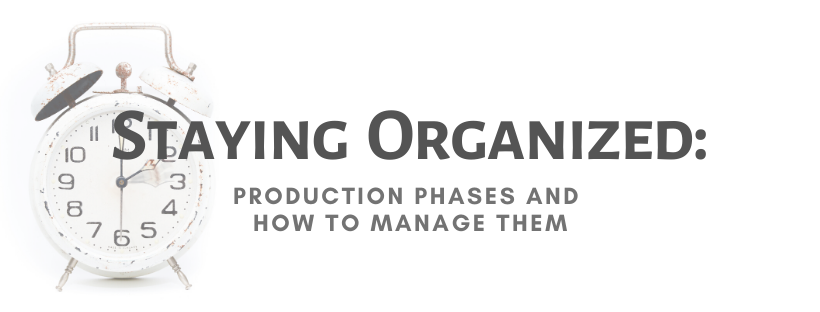If this is a new world to you, taking an idea and turning it into a full-fledged production is a daunting task. This whole blog is here to help you break it down, delegate it out, take it one step at a time, and all in all make the project a success. This post in particular is an overview of all the major steps to take your concept from idea to done.

Phase 1: Writing
Phase 1 is so easy and beautiful and you can make things happen whenever and however you want them – because it’s just you. No one’s asking you questions and the production is still months away and most people might not even know you’re working on it. There’s little pressure, just a lot of creative work and digging into Scripture and listening to hours of songs and wrestling with your own ideas. (Not sure you like your ideas? Check out Brainstorm Central for over 50 ideas). It’s all behind the scenes work, and these afternoons in a coffee shop are truly a delight.
At some point in Phase 1 is the pitch. It’s the email to the pastor saying “Hey, I have an idea and I’d like to show it to you” or it’s the going out for coffee with the music minister to present your finished script, or maybe it never really happened; you just ambled into Phase 1 knowing that you’d be responsible for creating something and making it happen.
Depending on your church’s culture and if you’ve done this before, you might do a lot of writing prior to the pitch meeting or you might get delegated the role early on and create the project afterwards. I usually have had a strong concept & partial outline before sending the initial proposal email, and a 90-95% completed script prior to the meeting with leadership.
What to do in Phase 1:
- Develop the concept and outline
- Write the script
- Choose the music
- Present to decision makers (if needed)
Your Deadline:
Phase 1 can be weeks or months depending on how far away the target production date is, but I would suggest that this stage should be completed at a minimum of 3-4 months prior to the production date.
Phase 2: Casting
Once you have the green light to make your program happen, it’s time to get the people who will be the voices and musicians. I usually write a pretty detailed email outlining the vision of the overall production and the part I would like to cast them in – speaking, singing, playing an instrument, etc. Often I ask the same person to do two or three parts.
Deadlines are your friend
My goal is to have the requests out and the first wave of answers back in pretty short order. If someone takes two weeks to then say no, you’ve lost that amount of time in finding the right person to say yes. So when you ask someone to participate, especially as a soloist, give them a hard deadline to respond.
Also, people talk. It’s a bit awkward to hear that your friend was asked to sing a month ago, and you just got an email yesterday from the coordinator inviting you too – makes you wonder how many people said no before you, right? Actually, I’ve sometimes avoided asking my most experienced/multi-talented people until I get the first wave of yeses and nos, because I know they can take on a couple different parts if needed (haha they’re like that blood type that’s a universal donor).
The early coordinator gets the Yes
And when you’re planning ahead to the casting phase, check the community calendar – if Easter is bookending Spring Break, you might have a harder time lining up people who are making out of town plans. I pretty much assume to have about a quarter to a third of responses be a no for the Christmas season programs but what I’ve also learned is that while a lot of people inevitably say no to different holiday events, if they’ve committed a yes in August or September, you’re not the one they’re saying no to!
What to Do In Phase 2:
- Match up speakers, singers, instrumentalists, readers, etc to each part in your program
- Order music in the appropriate key for each special number
- Create script & music binders and deliver to each participant
- Set up the first group rehearsal (if applicable)
Your Deadline:
Have all music and scripts out to participants 2-3 months prior to the production (2 months for a simpler service; if the group will be doing rehearsals together, 3 months is much better).
Phase 3: Rehearsals
Now is when the hard work you’ve been working on for so long starts to see the light of day. Whether you wrote the entire script yourself, or compiled extracts of Scripture around pieces of music, or some blend of the two, there is a certain quiet joy in seeing something that you’ve created start to take on a life of its own.
For my most involved production, where every person was a narrator as well as involved in the music, I set up a rehearsal calendar for each Sunday after church during the rehearsal phase. For my current Good Friday service project, each set (pianist & singer/s) is coordinating their own practices of their own accord and we’ll all get together once for a tech rehearsal.
Even though we won’t have any group rehearsals until the end, I’ll also check in with each musical number and ask to sit in on a practice, just to see how it’s coming along. I encourage each group to take the song and make it their own, I just love seeing them start to take shape.
What to Do in Phase 3:
- Coordinate or clearly delegate rehearsals
- Check in
- Set up final group rehearsal/s or tech rehearsal
Your Deadline:
Rehearsals take us all the way to the week of the production. If you’ve been running on time up til now, that means your cast has 8-12 weeks to learn their parts and get together with their singing partners to practice.
Phase 4: Logistics
As rehearsals continue, it’s time for you as the coordinator to make sure all the other pieces are coming together too. Anything else that needs to be decided, delegated, or done, is on you until you hand it off to someone else. Set design, programs, notes for the A/V team, communication with the church office – take initiative on these so that it’s rare for people to have to come to you first.
What to Do in Phase 4:
- Programs written & designed
- A/V team lined up
- Sound & lighting notes written and given to A/V team
- Ushers, childcare, other support lined up as needed
- Any costumes/set design, etc. decided upon and procured
- PowerPoint created
- Coordinate with church office as needed for pastoral opening prayer, auxiliary congregational singing that you’re not handling, etc.
Your Deadline:
Like rehearsals, these components go all the way up to the day of production, but it’s best for most of these to be decided on or sorted by about two weeks to go time – it just gives you buffer time to deal with any last-minute issues that may arise. That way, when you send around reminders the week of (which you should!) they will be reminders, not new information.
Phase 5: The Week Of
This is when everything comes together for real. Props and costumes are physically in someone’s car, the program comes out from the printer, the candle lighters are brought down from the attic and refilled, and the cast collects to do a final group and tech rehearsal.
What to Do in Phase 5:
- Print or have programs and additional scripts/cheat sheets for cast printed
- Coordinate any physical set up/staging of the platform
- Conduct final rehearsal and confirm expectation for dress code & arrival time for the production
- Send reminder emails to church office, head usher, A/V techs, cast, etc. with any final instructions, expectations, last minute changes and so on
Your Deadline:
Showtime!
So that’s it! 5 steps to take you from idea to production. What phase are you in right now? I’d love to hear about your project at designorganizecreate@gmail.com, and if you just came across this site, be sure to start here.

